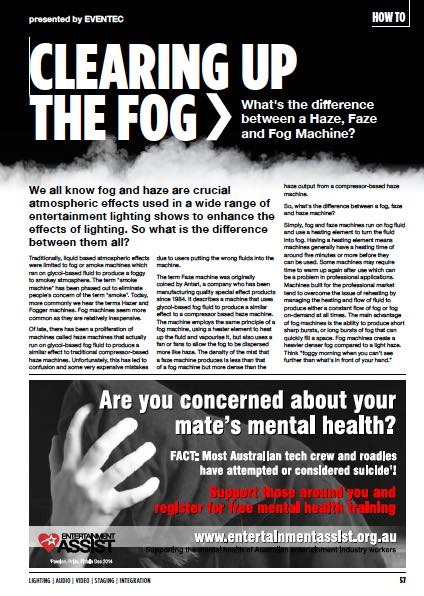News
10 Apr 2020
Clearing Up The Fog

Subscribe to CX E-News
What’s the difference between a Haze, Faze and Fog Machine?
We all know fog and haze are crucial atmospheric effects used in a wide range of entertainment lighting shows to enhance the effects of lighting. So what is the difference between them all?
Traditionally, liquid based atmospheric effects were limited to fog or smoke machines which ran on glycol-based fluid to produce a foggy to smokey atmosphere.
The term “smoke machine” has been phased out to eliminate people’s concern of the term “smoke”. Today, more commonly we hear the terms Hazer and Fogger machines.
Fog machines seem more common as they are relatively inexpensive.
Of late, there has been a proliferation of machines called haze machines that actually run on glycol-based fog fluid to produce a similar effect to traditional compressor-based haze machines.
Unfortunately, this has led to confusion and some very expensive mistakes due to users putting the wrong fluids into the machine.
The term Faze machine was originally coined by Antari, a company who has been manufacturing quality special effect products since 1984. It describes a machine that uses glycol-based fog fluid to produce a similar effect to a compressor based haze machine.
The machine employs the same principle of a fog machine, using a heater element to heat up the fluid and vapourise it, but also uses a fan or fans to allow the fog to be dispersed more like haze.
The density of the mist that a faze machine produces is less than that of a fog machine but more dense than the haze output from a compressor-based haze machine.
So, what’s the difference between a fog, faze and haze machine?
Simply, fog and faze machines run on fog fluid and use a heating element to turn the fluid into fog.
Having a heating element means machines generally have a heating time of around five minutes or more before they can be used. Some machines may require time to warm up again after use which can be a problem in professional applications.
Machines built for the professional market tend to overcome the issue of reheating by managing the heating and flow of fluid to produce either a constant flow of fog or fog on-demand at all times.
The main advantage of fog machines is the ability to produce short sharp bursts, or long bursts of fog that can quickly fill a space.
Fog machines create a heavier denser fog compared to a light haze. Think “foggy morning when you can’t see further than what’s in front of your hand.”
Every manufacturer tells you to only use their fluid in their branded machines, and never to mix or use fluids from other manufacturers or brands.
There is a very good reason for this, and it isn’t just to keep on selling you their consumables after the purchase of their machine.
Different fog machines are made to different specifications, and as such, the fluid each manufacturer makes is tailored to the machines they produce.
Specific fluid formulas require a specific temperature range to optimise the vapourised output the machine produces. Using fluid optimised to a different machine can result in incomplete vaporisation and result in wet fog where unvapourised fluid remains.
This is not only detrimental to the machine but can be downright dangerous leaving slippery wet residue on grounds or in the worst case the machine ejecting boiling hot liquid with the risk of coming into contact with people causing severe burns.
A compressor-based haze machine uses oil-based or water-based haze fluid which is broken up into small particles using a compressor which then exit the machine usually through a filter to keep the particles small.
The major advantage over a fog machine is the fact there is no warm-up time meaning haze can be instantly produced at any time. However, to fill a large space, the hazer would have to be turned on early to create the desired effect.
You may also find in the specifications for a haze machine, that it will refer to an air pressure figure which is an indication of the power or output of the machine.
The thickness of fog is due to its particle size. Particle size of fog is relatively large compared to other molecules in the air which is why the effect appears more like a fog or smoke.
With haze, the particles are much smaller. As a result, haze can be difficult
to see until light shines through it.
For this reason, haze is the preferred choice for theatrical applications as it does not obscure performers, yet it allows the effects of lighting to be enhanced.
The smaller the particle, the less visible to the eye the effect is without light, and then more dramatic as the light beam shines through.
Next comes the question of oil and water-based haze fluid for compressor-based haze machines.
Yes, compressor-based haze machines can use either, however once you use oil-based fluid in a compressor based hazer, the unit will always have oil residue in its tank. Therefore, it would not be advisable to switch to water-based fluid after using oil-based fluid.
If you use water-based haze fluid at the first, then chose to switch to oil based, it will not be as much of a problem, however manufacturers including Antari generally recommend against switching fluids.
So, why do people use water-based fluid over oil and vice versa?
Firstly, due to preference, but most commonly, some venues have certain rules about oil-based fluids so they have no choice but to use water-based haze fluid or foggers and hazers.
Sadly though, the water-based fluid does create a different looking haze and provide a lower volume of mist based on the same amount of oil-based haze fluid.
Oil-based haze fluid has a longer hang time but can, over time, leave residue around a venue and on equipment, which depending on the amount of use can be an issue.
If at a venue or event where there is an orchestra using wind instruments,
oil-based haze fluid cannot be used as oil-based particles in the air can cause wind instruments not to work properly.
In this case, water-based fluid would need to be used.
Here’s where the problem and confusion lies: there are machines on the market that are called haze machines that use heater blocks like fog machines and therefore require glycol-based fluid to create the effect, as opposed to mineral oil or water-based fluid that compressor-based haze machines use.
When purchasing a machine, or using one for a production or event, it is imperative to know which fluid will be required.
If the machine has a warm-up time, then it is most likely to use fog fluid, regardless of what the manufacturer calls the machine.
If there is no warm-up time, its most likely a haze machine that requires haze fluid. Fog machines run on a variety of fog fluids, depending on how dense the fog effect is required and how quickly the fluid is needed to dissipate.
A fast dissipating fluid like Antari’s FLC fluid can be used to simulate the CO2 effect and dissipate quickly, while heavy denser fluid can be used to maintain a thicker cloud that will take a while to dissipate like Antari’s FLR or FLG Fluids.
Mineral oil or water-based haze fluids are not interchangeable with glycol-based fog fluids.
Haze fluid cannot be used in a fog or faze machine and fog fluid cannot be used in a haze machine.
Use of incorrect fluids will damage machines and either void the manufacturers’ warranty or result in an expensive repair bill. Using fog fluid that is not specified for your fog machine can cause major health risks.
EVENTEC, exclusive distributor of Antari, describe a particular risk between propylene and glycol on their website at https://event-lighting.com.au/blogs/hands-on/fog-liquids.
Antari have a wide range of fluids and make it clear which fluids are for what machines in their specifications.
Other manufacturers may do so, but be wary of the use of the word “haze machine” when it is actually describing a “faze machine” which produces haze like effect but uses fog fluid.
CX Magazine – April 2020
LIGHTING | AUDIO | VIDEO | STAGING | INTEGRATION

Entertainment technology news and issues for Australia and New Zealand
– in print and free online www.cxnetwork.com.au
© VCS Creative Publishing
Subscribe
Published monthly since 1991, our famous AV industry magazine is free for download or pay for print. Subscribers also receive CX News, our free weekly email with the latest industry news and jobs.









